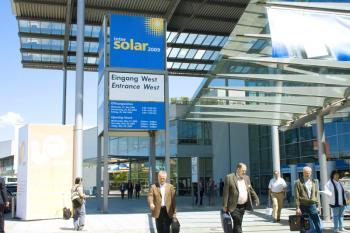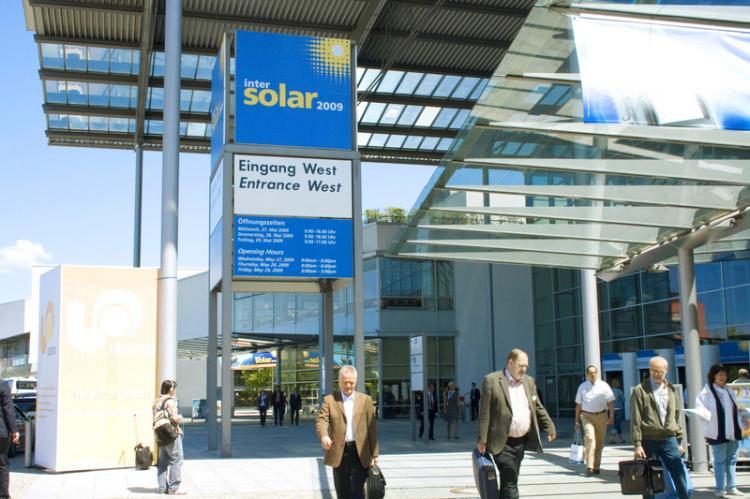The InterSolar Munich trade show is the world’s largest solar technology trade show. This year, 1,400 exhibitors participated –320 more exhibitors than the 1,080 in 2008. There were 2,000 representatives from the industry and 22 symposiums took place. The crowd of 60,000 onlookers were mostly interested in the solar energy exhibitions and information provided in the symposiums. We interviewed Markus Elsaesser, President of Solar Promotions, a firm that promotes and organizes solar technology trade shows. He hopes to gain a better understanding of the generated appeal of this trade show, in spite of the current economic crisis worldwide.
Epoch Times (ET): Why are so many people interested in solar energy, and why are they attending this show?
Markus Elsaesser (ME): InterSolar is a global trade show. This show is the largest of such shows worldwide, and is an international trade show. Every second exhibitor is a foreign company. From the beginning of our firm’s venture, we had hopes that it would become the largest international trade show, attracting visitors and exhibitors from different countries.
This is definitely the place to come to learn about other markets. We are not only interested in the German market, but also other European markets, as well as markets throughout the world. One can exchange thoughts, make sales connections and get educated about research programs from any country. We believe that our commitment to be an international exhibitor is the main reason for the popularity of this trade show.
We have representatives in many countries. We also have a presence in China, with a representative in Beijing. He is the contact point for InterSolar in China, and at the same time brings awareness about the trade show to China. We are trying to position Intersolar worldwide, and I think we are well positioned when it comes to international trade shows.
Secondly, market growth in Germany and in Europe is highly positive. Generally, we have had a double-digit growth rate every year. Also, our solar branches earn quite well, that is, Photovoltaic and Solarthermie account for about 9 million Euros annually. We employ 75,000 people in Germany alone. These are factors that contribute to the increasing interest in our product.
ET: At this time, the global economy is developing at a slower rate than in previous years. How does the current global crisis affect the trade show?
ME: If we look at the numbers, i.e., our growth rate, we don’t see the crisis affecting InterSolar. The growth rates are out of this world. But, if one looks more or less behind the scenes, then one can see that there is some evidence that the economic crisis affects our business. It has become more difficult for companies to finance larger projects.
ET: Did the global economic crisis lead to a slump in demand by customers?
ME: Over the past year, many large contracts were negotiated. Today, the world is settled with over capacity in the market. The demand was always higher than the supply, but that has changed. Today, we have more supply and less demand. In Germany, this has resulted in a 15 to 16 percent price reduction, compared to last year, for the customers of solar and photovoltaic systems. This is quite a considerable price reduction. This is the reason why the products are more attractive than ever to the customer, and it is more attractive to invest in solar power plants. Everyone who agrees to install a facility is guaranteed a reimbursement for the amount of solar electricity produced. The reimbursement amounts to an additional nine percent in reduced cost, which does not include the aforementioned 15 to 16 percent price reduction. This means that the annual rate of return is higher than ever before.
ET: This means that the demand would be boosted.
ME: We predict that the companies will do quite well during this year’s third and fourth quarter. Therefore, the organizations and we assume the installation capacity will equal that from last year. And it was rather high last year.
ET: I heard that they have developed new techniques in America’s Silicon Valley [in northern California], that result in even greater cost savings to the industry. Will you exhibit these new developments during this trade show?
ME: Yes, that is the case. Every year, this trade show is a great venue to bring new technological advancements to the customer and the media. During the past few days alone, there were hundreds of new technological advancements.
At this time, the talk is about reduction in production costs and this is, as you have mentioned, where Silicon Valley is making great advances concerning Duennschicht [thin film technology] and materials saving technologies. [Duennschicht is “thin film” technology. In its application to solar technology, it refers to the development of a lighter, thinner solar panel that contains less polysilicon. One disadvantage is that it is currently not as efficient at converting solar energy as the traditional silicon panels that currently dominate the market.] But they [thin film panels] are capturing the market and are taking an even greater market share. But compared to conventional silicon technologies, they are still in the minority. Market share is still rather modest, but is steadily increasing. And this is a technology that is not only aggressively advanced in the USA, but is also making inroads in Europe and China. There are many sales representatives. “Grid parity” is already anticipated for 2012. [i.e., photovoltaic electricity — solar power electricity — will be cost-competitive with conventional energy.]
ET: It was the same scenario with computer sales. In the beginning, computers were very expensive and not everyone could afford one. But then, suddenly the prices plummeted. Do you think that solar energy system prices will also come down in the near future, so that more people and most households can afford it?
ME: Yes, I believe this would be the case. The prices have already shown a steep decline. We saw price reductions of between 5 and 8 percent over the past years. At this time we have a special situation. Suddenly, we see price reductions of between 15 and 16 percent. But, the price reduction tendency has been going on for years. Because of larger sales and new technologies, the prices saw a steady decline.
Presently, the so-called “grid parity” is of great importance in the solar energy industry. This is the point in time where the price for the solar-generated electricity for the customer is the same price for the electricity received today through the power outlet. The price difference is no longer that steep. In Germany we expect solar energy to be even with conventional energy by 2012 or 2013, as the price of one rises and the price of the other experiences a reduction.
The price of solar energy has been decreasing about five percent per year and as mentioned earlier, this year it decreased by 15 to 16 percent. That means that the curves will meet at one time or another and will be even with one another. Then, solar energy will be an attractive alternative for everyone. Everyone could then afford a solar electricity system and have it installed on the roof. In areas or countries with higher incidences of solar radiation than in Germany, the time of parity will arrive much earlier. At the moment, government support is still needed; at least this is how it is in Germany. For example, in China, the conditions are not quite as good. But, there are other countries that are better off, and as long as one has a market presence, the market will allow for increased popularity.
ET: What, in your opinion, will be the portion of solar energy in the total energy consumption picture in the future?
ME: At the moment solar energy is about one percent of all energy generation. But, one needs to consider that the technique of industrial production of solar energy is relatively new and has not been available for too long of a time. Actually, one could say that it was not really available before 1999/2000, when the laws about renewable energy were enacted and such energy system installations became more attractive. After that, the industry invested increasingly more in building factories and capacity. When considered, this is a relatively short time since this industry began to develop, and yet has achieved one percent of solar parity. Now, the first step is there and the production capacity is there too.
Installation experts need to be trained, and now we have reached a point in time when development will accelerate. Studies suggest that by 2020 the market penetration will reach about seven percent, given that the basic conditions remain the same. It takes some time for the market to catch up.
For example, if China would enact a renewable energy law, similar to what we have in Germany, then the installation crew and the planners have to be trained. These people need the know-how and this just takes time. Therefore, it is important to begin earlier rather than later, because it takes several years before one reaches the point of profitability. Germany is still the number one place for new installations.
ET: Can you compare the use of solar energy between Germany and other European countries?
ME: For many years, Germany was in first place. Last year, Spain passed Germany, but this year, Germany was once again in first place. The reason for this is that Spain implemented the same model as Germany. However, they made a mistake. The fees were much too high and they did not consider the higher availability of solar radiation. The rate of return in Spain was astronomical, which resulted in companies moving to Spain and installing many large systems. These facilities were installed in open spaces, and they were really large facilities. In response, the Spanish government put brakes on this development, because it just went too fast.
Approximately 2,600 megawatt had been installed. This year, Spain will allow installation of 500 megawatts in total capacity. Seen from a global perspective, this is not bad. This is about the amount reached in the USA last year. In Italy, the installation was around 200 to 300 megawatts. Greece and France also seem to have good conditions. It is happening that more and more countries are getting into the game. But, this year, Germany will probably again be number one.
ET: Thank you for the interview.
Read the German article



Friends Read Free